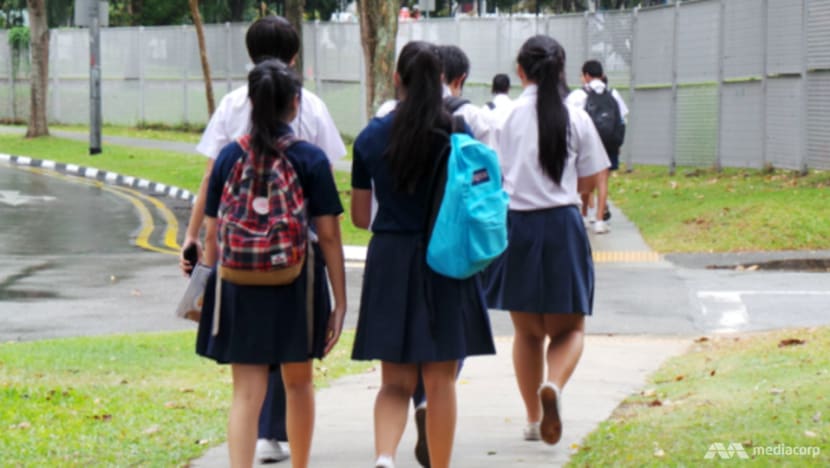commentary Commentary
Commentary: COVID-19’s education revolution - where going digital is just half the battle
Educators, parents and students have to find a way to use this outbreak to reimagine education, including what and how our kids learn, says Crystal Lim-Lange.

Graduates. (Photo: Jonathan Daniels/Unsplash)
SINGAPORE: Welcome to the world’s biggest leap in education.
Right now, 90 per cent of the world’s learners – more than 1.5 billion students - have been affected by school closures, according to OECD estimates.
In China, some 120 million Chinese students have been sitting in front of their televisions, learning through national broadcasts. Hong Kong students have been learning on digital apps since February.
In Lebanon, schools have been using online learning even for physical education, where students have been shooting and editing videos of their training and sports activities, learning digital skills as well as exercising.
Never before has there been a concerted global effort to digitise education.
A STEEP LEARNING CURVE FOR US ALL
Closer to home, my kids have been on home-based learning for two weeks now. Every day, I am flooded with emails from their teachers on the status of their homework submissions, reminders for them to participate in virtual hangouts, complete their video project on our dog, punctuality reminders and so on.
It is a steep learning curve for all of us, parents, students and educators. This truly is a historic moment in education.
READ: Commentary: Home-based learning can be an opportunity to rethink parenting
LISTEN: Home-based learning: Good, bad, terrible ... but mostly good?
We now are forced to break with decades of tradition but we also have the chance to reinvent what we want to learn and reimagine what education could be. Yet, how much of that are we doing?
So much of the world’s educational systems have been designed for the first Industrial Revolution era. Passive learning, linear thinking, early specialisation, one-size-fits-all teaching, for example – all geared towards building a work force adept at following instructions and being good at doing specific things.
While there has a lot of focus on going digital this home-based learning season, the bigger issue is that education needs to modernise and become more relevant. Digitalisation is both the solution and the challenge.

In this, there are two main issues to reimagining education - how to teach, and what to teach.
CHANGE HOW WE TEACH
Starting with the “how”, many academic institutions are unprepared for this sudden transition to digital platforms and have scrambled to offer move their lectures online.
But while COVID-19 is challenging assumptions regarding engagement and building connections, these attempts at modernisation have merely offered the same outdated educational content and the same passive teaching methods, but now facing a webcam plonked in front of them.
We forget something else is needed in the equation to spark learning when a distance is placed between the teacher and student.
My 11-year-old and 13-year -old tell me many of their teachers are just coming online to dish out instructions, and then leave them to complete projects at their own pace.
“They say if you finish early, you can go and read a book. I don’t really feel motivated with all this free time. And also there is no flexibility to change the teaching because the timetable is set in the morning so everyone just has to stick with it,” the 11-year-old said.
READ: Commentary: The joys and frustrations of home-based learning
READ: Commentary: Home-based learning is strange, new ground. But we can conquer that too
My 13-year old grumbled: “The problem is that they aren’t very clear about their instructions, and they just say things once and then leave us alone to figure it out.”
Research in learning science tells us the human brain needs special care in digital environments to avoid the temptation of distractions and maximise the learning experience. Educators need training in how to teach differently on these platforms, when this old method of teaching by instructing, asking and reviewing is stifling engagement.
Part of the issue may be that video conferencing solutions are not necessarily the right tools to deliver learning, and come with their own challenges such as connection bandwidths, security and privacy.

Our education systems have done a good job making the jump onto digital platforms and must now focus on how to make digital learning count. So how about changing up teaching to nurture thinking rather than to dish out instructions?
FOCUS ON INTERACTING AND DRAWING RESPONSES, RATHER THAN INSTRUCTING
I had an opportunity to witness a lesson in progress at Minerva Project, a futuristic university headquartered in San Francisco regarded as a pioneer in the world of higher education recently.
The teachers working through a custom-based digital platform, acted much more as facilitators, provoking thought and stimulated discussion, while speaking for less than 15 per cent of the class time.
Lessons started with a “hook” at the beginning of a new learning topic —a visually stimulating image, an emotionally striking story or a thought-provoking question that caught attention, then students were placed in breakout rooms to work on short live projects.
Short quizzes and polls peppered each class, and students were called on constantly to give their opinions, summarise the arguments presented by their peers so far, play devil’s advocate, and even to step in for the teacher and moderate.
It was a refreshing and thoroughly modern experience. It succeeded also because investments were made in having faculty undergo months of training in the principles of learning science and online facilitation.
It might sound like a daunting task but such investments in shaping the minds of our digital natives across all learning ages will go a long way. For one, similar principles may be needed in engaging our younger learners as well, given their short attention span.
READ: Commentary: No ordinary disruption – a rising generation meets the coronavirus
READ: Commentary: How to sabotage your child’s future – five dangerous notions about life, careers and education
Teachers can screen share short videos, unexpected questions, riddles or puzzles at the start of the class to keep students guessing what the answers may be, to be revealed through the lesson.
Quizzes and live polls are useful in gauging if their young audience is following or if they are lost.
Students can be placed in twos or threes into breakout rooms and given clear instructions on the topic to discuss or problem to solve and work on their presentations to the class.
Student groups work at different paces so plan for flexibility and have supplementary materials for groups that may finish earlier.
As student groups present, engage the class by asking them to give a rating or even to indicate using one or two or three fingers what their rating is.
READ: Commentary: Singaporeans more adaptable than they give themselves credit for
READ: Commentary: It’s not just work and the economy. COVID-19 is also changing how we use social media
A big part of learning is also documenting or writing things down, so collaborative documents such as whiteboards or google docs can be shared and various students assigned the role of scribe at different points.
Learning can be broken up with short energiser exercises to relieve the monotony of sitting.
For younger age groups, parents will probably also have to step up, help support the teaching role and act as tech support, as students do not necessarily know how to stay attentive to courses not adapted to the digital medium.

Educators could also afford to brief parents on simple ways which they can aid students learn, since there is no running away from the part-time role mums and dads will have to play, while being careful not to overloading parents with a deluge of information for each child.
CHANGE WHAT WE TEACH
The second, and perhaps bigger issue, is what to teach. What will be relevant in our brave new world?
The rapid spread of COVID-19 has demonstrated the importance of developing resilience to cope with the volatility and uncertainty of the future, from pandemics to climate change.
READ: Commentary: If we can share or hitch rides, why not food delivery?
LISTEN: Disruption 101: How COVID-19 is revolutionising work
As parents now have a front-row seat into what their children are learning, many parents are now asking, why are my kids spending so much time learning things we ourselves have never used as adults - like quadratic equations, logarithms, the formation of an oxbow lake and iambic pentameter?
While some might argue these are foundational skillsets in logic and math, should we not devote the same amount of attention, if not more, to future-ready life skills like critical thinking, creativity and innovation, marketing and communications, financial literacy and resource allocation, coding, psychology and mindsets, entrepreneurship and so forth?
This may involve a strategic overhaul of curriculum so that we are not just adding more to our already weighty student workload, and a huge dose of imagination and creativity to weave some of these new Fourth Industrial Revolution competencies.

For instance, with the shuttering of science laboratories across universities, the Genetics Society of America suggest science students practise writing grant proposals instead, weaving in persuasion and marketing skills and financial budgeting skills, or use data visualisation tools to present statistics in a compelling new way.
FOCUS ON BRAIN HACKING
Another novel solution is Minerva’s approach of flipping the curriculum. Normally in most schools, the primary focus of teaching is the subject matter (e.g. Math or Geography). Teachers claim that in the learning of these subjects, students somehow also pick up secondary thinking skills and life competencies.
Minerva reverses the equation. Their first year is dedicated to just three foundational things – critical thinking, creative thinking and effective communication.
“It’s basically brain hacking” says Ben Nelson, Founder of Minerva Project, “We’re changing the way you perceive the world around you.”
Only after the first year of learning to think well, do students choose a major and take subject matter courses, but the principles of critical thinking, creative thinking and effective communication are embedded into every single subject matter class.
READ: Commentary: The rise of the digital economy – and how education may be transformed
READ: Commentary: Why aren’t there more Singaporean CEOs?
This radical approach requires all teachers to go through training to learn the foundational life skills and Fourth Industrial Revolution competencies so that they understand how to weave these into their subject matter classes.
You can imagine many educators are reluctant to embrace this big shift as it involves much unlearning and relearning, but yet is a vital part of what our youth need.
THE VALUABLE OPPORTUNITY COVID-19 PRESENTS
The word "crisis" means "to sift" and comes from ancient Greek times. It refers to a critical moment where we must decide and choose what is essential.
COVID-19 poses a valuable opportunity to remind ourselves that the bigger picture skills students need in this unpredictable world are meta-skills that they can apply to many different scenarios, for example, creative problem-solving, focus and perseverance, critical thinking, and above all, adaptability.
To parents who may be fretting about whether their children will catch up with the demands of the curriculum and can cross that end-year exam bar, consider that your children are now learning things that are far more important to their future.
As our youth watch this pandemic unfold, they are learning lessons about how interconnected we all are, and what globalisation really means.
They are learning how fragile our ecosystem is, the miracle of the human body and its various unbelievably intricate mechanisms.
READ: Commentary: The great COVID-19 race for protective medical gear and ventilators

Could the issues COVID-19 throw up not offer a rich source of engagement for children to apply these skillsets to whether in subjects like Science, English or Social Studies?
THE ONCE-IN-A-LIFETIME CHANCE TO REIMAGINE EDUCATION
Parents too have an outsized role this home-based learning season outside of the digital classroom. As your children watch you adjust to working from home, they are learning from you how to navigate uncertainty and respond to life’s challenges.
Pretty much everything is a new learning experience for them. While they walk past cordoned-off playgrounds and closed swimming pools and empty movie theatres with aching hearts, they are recognising the value of human connection, and acknowledging there is a limit to how much fun they can have on screens alone.
Let us not squander the opportunity this crisis offers and rebuild our education systems thoughtfully and intentionally, celebrating resilience, creativity and adaptability as the cornerstones of what it means to be educated in this brave new world.
BOOKMARK THIS: Our comprehensive coverage of the coronavirus outbreak and its developments
Download our app or subscribe to our Telegram channel for the latest updates on the coronavirus outbreak: https://cna.asia/telegram
Crystal Lim-Lange is the author of Deep Human- Practical Superskills for a Future of Success and the CEO of Forest Wolf, a leadership and resilience training consultancy.














